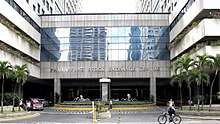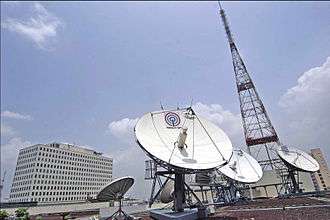Philippine Stock Exchange
The Philippine Stock Exchange, Inc. (Filipino: Pamilihang Sapi ng Pilipinas; PSE: PSE) is the national stock exchange of the Philippines. The exchange was created in 1992 from the merger of the Manila Stock Exchange and the Makati Stock Exchange. Including previous forms, the exchange has been in operation since 1927.
| Pamilihang Sapi ng Pilipinas | |
.svg.png) | |
(2018-06-04).jpg) The new Philippine Stock Exchange headquarters in Bonifacio Global City, Taguig | |
| Type | Stock exchange |
|---|---|
| Location | Philippine Stock Exchange Tower (One Bonifacio High Street) 5th Avenue cor. 28th Street, Bonifacio Global City, Taguig, Metro Manila, Philippines |
| Founded |
|
| Owner | The Philippine Stock Exchange, Inc. |
| Key people |
|
| Currency | Philippine peso (₱) |
| No. of listings | 328 (2019) |
| Market cap | |
| Indices | PSEi |
| Website | www |
The main index for PSE is the PSE Composite Index (PSEi) composed of thirty (30) listed companies. The selection of companies in the PSEi is based on a specific set of criteria. There are also six additional sector-based indices. The PSE is overseen by a 15-member Board of Directors, chaired by José T. Pardo.
History
(2018-06-04).jpg)

On February 3, 1936, the Securities and Exchange Commission announced that it had "relinquished control of the Manila Stock Exchange."[5]
The Philippine Stock Exchange was formed on December 23, 1992 from the merger of the Manila Stock Exchange (MSE) (established on August 12, 1927, based on Muelle de la Industria, Binondo, Manila) and the Makati Stock Exchange (MkSE) (established on May 15, 1963, based in the Makati Central Business District, within Ayala Tower One). Both exchanges traded the same stocks of the same companies.
In June 1998, the Securities and Exchange Commission (SEC) granted the PSE a "Self-Regulatory Organization" (SRO) status, which meant that the bourse can implement its own rules and establish penalties on erring trading participants (TPs) and listed companies.
In 2001, the PSE was transformed from a non-profit, non-stock, member-governed organization into a shareholder-based, revenue-earning corporation headed by a president and a board of directors and on December 15, 2003 listed its own shares on the exchange (traded under the ticker symbol PSE).
Record values
| Category | All-Time Highs | |
|---|---|---|
| Closing | 9,041.20 | Friday, January 26, 2018 |
| Intraday | 9,078.37 | Monday, January 29, 2018 |
Business
On January 4, 1993, the former Manila Stock Exchange started the computerization of its operations using the Stratus Trading System (STS) with a company called Equicom. On June 15, the former Makati Stock Exchange adopted the MakTrade trading system. Both systems were linked on March 25, 1994 to produce a One Price-One Market exchange. Two years later, on November 13, 1995, the implementation of the Unified Trading System (UTS) allowed the use of a single-order-book system on a MakTrade software where all the orders are posted and matched in one computer.
In October 2004, the Securities Clearing Corporation of the Philippines (SCCP), a clearing and settlement agency for depository eligible trades, became a wholly owned subsidiary of the PSE. The SCCP acts as the settlement coordinator and risk manager for broker transactions as well as administrator of the trade guaranty fund.
In 2005, the PSE adopted an online daily disclosure system (ODiSy) to improve the transparency of listed companies and ensure full, fair, timely and accurate disclosure of material information from all listed companies. The ODiSy provides a 24/7 online system access for the submission of all types of disclosures.
On July 26, 2010, the PSE launched its new trading system, PSEtrade, which replaced the MakTrade system. The system was acquired from the New York Stock Exchange.
On June 22, 2015, the PSE launch its new trading system, the PSEtrade XTS, which will replace the PSEtrade system acquired from the New York Stock Exchange. The new trading system will be acquired from the NASDAQ
In 2016, The Marquee Awards of Alpha Southeast Asia magazine recognized PSE as the Best Stock Market in Southeast Asia for the year 2015.[6] The Alpha Southeast Asia, Named PSE Again as the Best Stock Market in Southeast Asia in 2017, for 4 Times in 5 Years.
In 2019, The PSE has introduced a new index that will help track the overall returns of the main index, The Total Return Index (PSEi TRI), as part of the efforts to create a broader investor base for the market. [7]
Record highs
On March 2, 2012, the PSE Composite hits 5,000 mark the highest record close. However, on December 12, 2012, almost ten months after, it neared the 5,800 mark closing in 6,000 near the end of the year.
On January 7, 2013, the PSE Composite gets to all-time record at 6,000 mark. In March it again broke another record by ending the trading day at 6,847.47 after Fitch Group upgraded the Philippines for the first time to investment grade status .[8] On May 10, 2013, it achieved its 29th record close for the year closing at 7,262.38, surpassing the previous record of 7,215.35 on May 3. On May 15, 2013, the PSEi hit its 30th all-time high of 7403.65 and ending the day at 7,392.2. However, the tapering by the Federal Reserves in the United States caused the PSEi to end at 5,889.83.
On April 6, 2015, the PSE Composite the 8,000 mark and closes on another record by ending the trading day at 8,053.74. In 4 days it broke another record by ending the trading day at 8,127.48
On January 26, 2018, PSEi breached through 9000 for the first time, ending at 9,041.20, up by 42.03 points, or 0.47%.[9]
Current trading floors
Trading on the PSE pre-opens at 9:00 A.M.; opens at 9:30 A.M.; is in recess between 12:00 and 1:30 P.M.; pre-closes at 3:15 P.M.; in run-off from 3:20 P.M.; and closes at 3:30 P.M.[10]
The unified trading floor is now located in the Philippine Stock Exchange Tower (PSE Tower), the new headquarters of The PSEi, located in One Bonifacio High Street, in Bonifacio Global City, replacing the two trading floors in Metro Manila: one at its headquarters at the PSE Plaza Ayala Triangle, Ayala Tower One in the Makati Central Business District (Makati Stock Exchange); and one at the Philippine Stock Exchange Centre (Tektite Towers), Ortigas Center in Pasig (Manila Stock Exchange).[11][12][13][14]
Indices and components
The PSE has eight constituent indices:
- PSE All Shares Index (ALL)
- PSE Composite Index (PSEi)
- PSE Financials Index (FIN)
- PSE Holding Firms Index (HDG)
- PSE Industrial Index (IND)
- PSE Mining and Oil Index (M-O)
- PSE Property Index (PRO)
- PSE Services Index (SVC)
- PSE Total Returns Index (TRI)[7]
- PSE SME Sector (SME)
The PSEi is the main index of the PSE, while the All Shares Index is the broader index of the exchange. The remaining six indices are sector indices based on a company's main source of revenue. Although listed in an index, companies are listed on the PSE under the First Board, Second Board or the Small and Medium Enterprises Board based on market capitalization.
As of September 15, 2014, the Philippine Stock Exchange has 261 listed companies with a total market capitalization of Php17.41 trillion. There are 133 active trading participants registered at the PSE.[15]
The PSE also offers Exchange Traded Funds through the First Metro Philippine Equity Exchange Traded Fund, Inc.
See also
- Philippine Dealing Exchange
- List of market opening times-
References
- See "History" tab at http://www.pse.com.ph/corporate/home.html
- "Market capitalization hits P13.95t". Manila Standard. Retrieved January 20, 2020.
- "Philippine Exchange (PSE) Overview | TradingHours.com". www.tradinghours.com.
- "Global Stock Market Hours & Holidays - NYSE, NASDAQ - Stock Street". Stock Street. Retrieved April 30, 2018.
- "SEC Ends Control of Manila Stock Market; San Francisco Mining Obtains Registration". The New York Times. New York City, New York. February 4, 1936. p. 31. Retrieved April 4, 2017.
- "PSE named 2015 best stock exchange in Southeast Asia". Rappler. January 4, 2016. Retrieved January 5, 2016.
- "Bourse operator to introduce PSE total return index". February 3, 2019.
- Dumlao, Ubac, Remo. "Early Easter gift for PH". Retrieved March 28, 2013.CS1 maint: multiple names: authors list (link)
- "PSEi breaks 9000 barrier for the first time". Rappler. Retrieved June 26, 2018.
- "PSE extends pre-close period". philstar.com.
- "PSE starts trading in new headquarters". ABS-CBN News. Retrieved February 19, 2018.
- Pastrana, David. "Philippine Stock Exchange BGC: A Brand New Home for Stock Trading". http://kmcmaggroup.com. KMC MAG Group. Retrieved October 23, 2014. External link in
|website=(help) - "Philippine Stock Exchange BGC | BGC Office for Rent".
- "THE PHILIPPINE STOCK EXCHANGE, INC".



